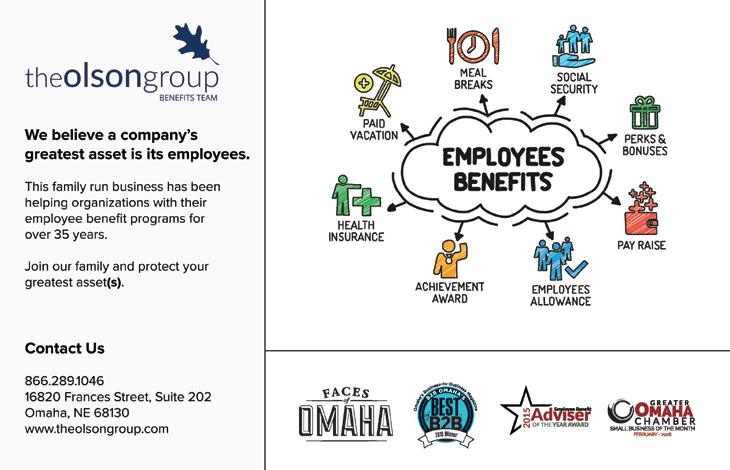
6 minute read
NEBRASKA’S GRAY DRAIN FLEEING RETIREES A LOSS FOR THE STATE
If you’re daydreaming of retiring to traditional havens like Florida, Arizona, and Nevada, here’s a one-word retort: Nebraska.” That was Paul Davidson’s snappy opener for his July 10, 2019, USA Today article titled “Sorry, Florida and Nevada: This state ranks as the best for retirement.” The piece was in response to Bankrate.com’s annual ranking of the nation’s best states to live out your golden years. According to the rubrics of affordability, wellness, weather, culture, and crime (in that order), Nebraska came out on top.
The problem? Nebraska’s retirees don’t seem to agree. Forget the much-ballyhooed “Brain Drain” of Nebraskans in their 20s leaving the state. Retirees aged 55-70 are also packing moving boxes and taking their tax dollars and spending power with them. They make up Nebraska’s “Gray Drain,” and the cost to Nebraskans entails more than just a financial loss.
What accounts for this “out-migration” of graying tax payers? Experts often cite how individual states approach retirement income. Florida, Nevada, Washington, Tennessee, Texas, South Dakota, Wyoming, and Alaska don’t tax retirement income at all, whereas other states don’t tax Social Security benefits or they implement tax credits and/or exemptions to assist retirees. Only 11 states currently tax Social Security, including Colorado, Connecticut, Kansas, Minnesota, Missouri, Montana, New Mexico, Rhode Island, Utah, Vermont, and Nebraska.
Jim Vokal chief executive officer for the Platte Institute, which advances policies that remove barriers to growth and opportunity in
Nebraska laments the state’s lack of incentives for senior citizens. “I hear constantly from retirees who say, ‘I just can’t afford to live here.’ I think it’s largely, if not mostly, based on our uncompetitive tax situation compared with that in other states.”
That will soon change, as Nebraska will be off the list of states that tax Social Security. On May 31, Governor Jim Pillen signed tax reform legislation that he labeled “transformational” for Nebraskans. In addition to reducing individual and business income tax rates to 3.99% by tax year 2027 and providing tax credits related to childcare, LB754 accelerates tax exemption for Social Security benefits, which will go into full effect in 2024.
While this legislation is a step in the right direction, Vokal cited other concerns, such as estate planning. “We’re one of five states [alongside Maryland, New Jersey, Pennsylvania, and Kentucky] with an inheritance tax. It’s on the mind of seniors, who want to pass on their assets. [It used to be six: Iowa repealed its inheritance tax in 2021 and is phasing inheritance taxes, with the last inheritors paying a reduced rate through 2024.] These folks have tremendous financial options, even in states that are cool during winter like Nebraska. We lose retirees to North Dakota, Missouri, Kansas, and Iowa the list goes on. It’s a cumulative effect.”
David Drozd, director of research and data analysis at Community Health Development Partners, knows about those cumulative effects. The demographer conducted an exhaustive study on Nebraska’s migration for the University of Nebraska at Omaha’s Center for Public Affairs Research in 2020. While that analysis focused on Brain Drain, it also indicated the impact of retirees leaving the state.
“NEBRASKA HAS STRUGGLED WITH OUT-MIGRATION FOR A LONG PERIOD OF TIME. WHAT I FIND WITH NEBRASKA’S OLDER POPULATION AND THEIR OUT-MIGRATION IS THAT IT’S VERY CONSISTENT. FOR AGES 55 TO 74, IT HAS OCCURRED EACH OF THE PAST 12 YEARS AVERAGING 800 PEOPLE ANNUALLY. THAT DOESN’T SOUND LIKE MUCH, BUT OVER A DOZEN YEARS, THAT’S ALMOST 10,000 PEOPLE.”
-DAVID DROZD
“Nebraska has struggled with out-migration for a long period of time,” Drozd said. “What I find with Nebraska’s older population and their outmigration is that it’s very consistent. For ages 55 to 74, it has occurred each of the past 12 years averaging 800 people annually. That doesn’t sound like much, but over a dozen years, that’s almost 10,000 people.”
Noting that this is the first data point, Drozd continued by citing retirees who leave other states. “We are only the 35th best in terms of senior migration. We’re similar to Kansas, which is 36th. That is in comparison to other states with bad weather and high taxes who rank at the bottom, like New York, Connecticut, New Jersey, and Illinois. And Nebraska consistently loses people to the coldwinter states South Dakota and Wyoming, which have no state income tax.” CONT.


Yet another critical data point: Gray Drain’s financial impact. “Say the average income is $50,000,” Drozd posited. “If the state income tax rate is 5%, that’s $2 million a year in lost Nebraska state tax revenue. That’s $24 million over 12 years in simple math. Accounting for the aggregate impact of that income not being taxed in Nebraska year after year once people leave, it’s $153 million over 12 years.”
John worked in the insurance industry until 2013) now makes their home in Estes Park, Colorado. The Naughtons purchased their cabin in 1990 as a summer retreat and eventually remodeled it for winter living. They sold what they fondly called their “big family home” in 2014 and made the move from Omaha to Colorado.
“I just love the mountains,” Phoebe confessed. “It’s where we wanted to retire. It wasn’t really about the cost.”
That isn’t to say that the Naughtons don’t track their monthly expenses. John is quick to point out the difference between the two states. “On balance the higher cost of living evens out the lower taxes in Colorado,” he said. “The cost of gas and daily transportation can be very expensive. Food in grocery stores is taxed. There are other pieces to the puzzle outside the tax structure.”
But we need to be more competitive. The reason why this is so important is the leading edge of baby boomers are now hitting 75. The tail end will hit 65 for the next 10 years. The potential loss is a large social and financial impact.”
Michael Lucci, senior policy advisor at the Platte Institute, is similarly concerned. “Baby boomers have half the nation’s wealth. They’ve been saving their whole lives. We do not want their spending and investment power out of the state.”
Meanwhile, retirees like the Kellys and the Naughtons continue coming “home” to Nebraska, at least for extended stays, dividing their golden years between Ohio and Colorado, respectively, and Omaha, where they’ve spent the majority of their lives.
“The loss to Nebraska and its citizens is great,” Vokal concurred. “There is a correlation between out migration and the loss of income to the state. It puts more pressure on everyone else to fund the government. Another less-tangible cost is the one to the community. There is an impact on the family not having elders around to experience life’s monumental moments. I can’t imagine my kids not having their grandparents around.”
Although that aspect is less quantifiable, Drozd said. “It’s not just dollars and cents. These folks, especially if they have a bachelor’s degree, are more likely to be civically engaged in clubs and as volunteers and to have leadership roles. We don’t just lose their spending power, but intangibles to the community.”
But are taxes the main driver behind Nebraska’s Gray Drain? Not necessarily.
“It’s not just the finances,” said Nick Shannon, a retirement planning financial advisor and founder of Prestige Wealth. “Climate and family dynamics are big components in determining primary residence. Family plays, I would argue, an even more important role, and Nebraska is very family friendly although we can’t completely ignore finances.”
Phoebe and John Naughton, both 75, are a prime example of Nebraska’s Gray Drain. The couple (Phoebe retired from education in 2007, whereas
In that respect, Nebraska places above other states. Depending on the source, the cost of living in the state is between 5% to 8% below the national average, a savings that adds up over time.
As Shannon indicated, another major driver behind the Gray Drain is family, and the proximity of both children and grandchildren.
Mike Kelly, 74, was a reporter and columnist for the Omaha World-Herald for almost 50 years before retiring in 2018. He and his wife, Barbara, then relocated to Cincinnati, Ohio, where both have family, including two of their four children and six of their 11 grandchildren.
“We did not think at all in terms of financial or tax reasons,” he said. “It was about family.”
Of course, moving to be near children is inextricably linked to the Brain Drain. If people in their 20s leave the state for career opportunities and lifestyle and cultural reasons, and family remains a chief reason for retirees’ relocating, getting rid of taxes on Social Security payments may not be enough to entice them to remain in the Cornhusker state.
“When it comes down to family, there’s a risk of Nebraska’s Brain Drain,” Drozd explained. “Seniors want to be near their grandchildren. Phasing out taxes on Social Security will help anything helps.
The Naughtons, while cherishing their time in Colorado’s mountains, rent a small home in Omaha from September 1 through May 31 every year. “For a while, we had a lot of little grandkids here,” John said, noting that even though those families eventually moved out of state, he and Phoebe continue to renew their Omaha lease. “I’ve had Creighton basketball tickets since 1966,” he chuckled, “plus all our friends and acquaintances still live in Omaha.”
That sense of belonging, kinship, and community is key.
“I’m very grateful to spend time here because I love and am very attached to Omaha,” said Kelly, who visits the metro about six times a year and remains registered with Sacred Heart Catholic Church. “This is where I know people. I still consider Omaha home.”
Shannon isn’t surprised that retirees like Kelly and the Naughtons divvy up their residential time. “Sometimes it’s about identity. People spend their lives and careers here and have community. It’s important to build in flexibility to be able to visit or vacation where you want.”
For more information, visit platteinstitute.org; cpar. unomaha.edu; and prestigewealthne.com.
B2B
FEATURE | STORY BY KARA SCHWEISS | PHOTOS BY BILL SITZMANN










